Caribbean, Part III – If it’s Monday it must be… Antigua
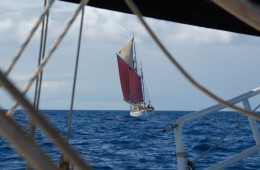
From Dominica we limped northwards, borne by the flimsiest of breezes. The Saintes and Marie Galante drifted slowly into view and then began to sidle past. The breeze eventually picked up to about force 2, but the southern shores of Guadaloupe were still a few miles distant when our progress was suddenly arrested altogether.
“Something round the rudder,” I shouted.
From the aft cabin, where I happened at that moment to be working, the sound of graunching was unmistakable.
By the time I hit the deck the boys had already identified the problem. It was a net – yes, another net – but this time the hazard was a waif, carried on the current. Supported by two dented, barnacle-encrusted jerry cans, it had evidently been torn away from some fisherman’s trap – torn, one supposes, by the propellers of a big ship – and now it floated aimlessly about, futile but still deadly, ready to ensnare everything from a medium-sized fish or a careless turtle through to a fifty foot yacht.
“We’ll get it aboard,” said Nick, somewhat ambitiously.
“First we’ve got to get it off the rudder,” said Caesar.
“We’ll have to dive on it,” said I.
“We’ll have to stop the boat to dive on it,” said the PADI qualified Advanced Open Water Dive Master.
We dropped the sails, I donned my mask and snorkel – and a harness and tether – and I took up my knife.
The sea was wonderfully warm – indeed, I quickly realised that to be in the water was a pleasure, not a chore – but although we had dropped our sails the boat was still sailing along at almost a knot. Worse, she was rolling to and fro like a buffalo in a wallow. I trailed astern and peered at the mess of string and rope which had knotted itself around the rudder. Which piece of line should I aim to cut in order to free Mollymawk from the fetter? The piece which led to the buoys, now banging on the transom, or the tangled mess which led to that ghostly outline following along astern of the boat?
It was at this moment that I recalled reading of a recent incident in which a fellow cruising man went over the side to clear his prop and was brained and killed by the boat bouncing on his head.
A 28 ton sledge-hammer… Now I came to think of it, Caesar had a point…
But what else could we do? We certainly couldn’t tow this train all the way to Antigua.
I ducked my head under the water again – and, lo and behold, the ropes and the net were gone!
When I looked up again I saw that Nick was standing on the poop, triumphantly waving a boathook and, in the other hand, the jerrycans. “I couldn’t get the net, but it’ll sink now, without these to hold it up.”
During this episode, Cherub, which had been a mile or more astern, came sailing through to overtake us.
“What are you playing at?” Xoë called out. “Why have you dropped your sails? Have you torn them again?”
“‘Just caught an enormous fish, ” I lied. “It was so big that we had to stop the boat to land it – you should have seen the size of the thing! – but it got away.”
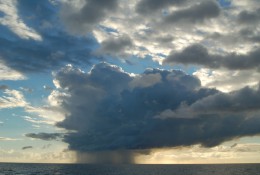
At sunset Cherub headed in towards the island of Guadaloupe, hoping to find the evening breeze which ought to pour down the slopes at the close of a sunny day. But the day had not been such a one – or, at any rate, not over Guadaloupe. While we drifted along in the sunshine the island had spent the day sulking under a big grey cloud.
We sent Mollymawk a couple of miles further offshore, where the cloud top reached out towards one of its smaller bretheren and formed an arch. This kind of formation usually encourages squally weather, and this was just what we needed at this time.
Soon we were romping along in a force four, laughing at the rain and trying not to sneer at the cherubim, who were becalmed close by the island.
The following morning found us limping past Montserrat with a torn mainsail… (Regular readers will recall that the mainsail is rotten and invariably splits a seam in anything above a force three.)
Smoke drifted from the top of the volcano, and we thought of St Pierre and wondered how anyone could be brave enough – or foolish enough – to set up camp in its shadow. The town which we visited almost 20 years ago now lies buried under a mantle of grey lava, but the British government, in its wisdom, has declared that a settlement founded on the north-eastern shore will be safe from the attentions of the fire-breathing, sulphur-belching dragon. What faith people place in the pronouncements of their government!
Jolly Disappointing
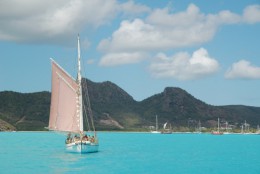
Despite the fact that Mollymawk had been disabled throughout most of the night her early lead ensured that we were still five miles ahead of our companions. As we worked our way past Cades Reef and dodged amongst the shoals to the north we could see the gaffer’s tan sails perched on the horizon; a burnt-sienna smudge on the dark blue rim of a turquoise sea. We were on old familiar territory now – but not on the territory which was most familiar of all to us.
Ideally we would have liked to begin our return visit to Antigua by sailing into English Harbour and dropping anchor off the dockyard. That was what we used to do in the old days, what? Unfortunately, however, the rules and regulations in Antigua have changed during the course of the past 17 years and clearing into the country in English Harbour is now a rather expensive business. Thus it was that we had decided to clear in at Jolly Harbour.
Jolly Harbour didn’t exist when we were young’uns. While Nick and I were living and working in English Harbour this development on the south-west coast was just somebody’s pipe dream. Well, now the dream has become a reality… Sort of.
The dream was of a vast complex consisting of hundreds of stylish apartments and villas decoratively arranged around a haven over-flowing with luxury yachts and gin palaces. Lunch on the wooden verandah outside the Jolly Pirate; lobster thermidor, conch rottis (the local fare) served with imported lettuce and wait whain. Boutiques stocked by La Costa, Ken Done, Gucci, and Louis Vuitton. Awl-grip topsides publishing reflections of the super-yachts moored alongside; glistening varnish; flags flapping in the jolly breeze; sun-downers on the balcony, over-looking the stainless steel and GRP forest; “Do have another cocktail, Dahling!” Oh, drool-drool-drool (if you like that kind of thing…).
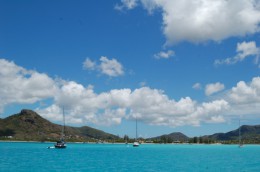
The reality is a rather drab and shabby set up, consisting of some flats (mostly unsold, we hear) and an arcade of small shops (including a chemist or pharmacy, two car hire offices, a bank, and no boutiques.) The marina at the head of the lagoon was fairly busy, but our enduring impression is of a vast, vacant stretch of water fringed by empty apartments, on the one side, and on the other side by a building plot.
The only really lively thing was the boatyard, which seemed to be thriving.
But we hadn’t come to Antigua to see Jolly-ville. And we hadn’t come to JH to enjoy the facilities; we were here to clear in.
Antigua is actually one of the cheapest islands in the Caribbean to clear-into, provided you don’t do it in the national park (ie. in English Harbour or Falmouth).
Yachts clearing-in in the Park have to pay Park fees, and these are calculated according to the size of the boat and the number of crew.
Yachts clearing-in through Jolly Harbour pay for a cruising permit which entitles them to visit all of the other anchorages, including EH and Falmouth.
(Yachts can also clear-in in St John’s, the capital, but whereas this was once a perfectly straightforward process we hear that it is now a major hassle.)
In Jolly Harbour the formalities are conducted in a series of kiosks at the head of the bay. New arrivals should simply enter the harbour and proceed along the channel until they spot the yellow Q flag flying above the buildings. One can either take the boat in, and moor to the jetty, or else row ashore in the dinghy.
Jolly Good Company
We quickly discovered that the “scene”, in Jolly Harbour, is not to be found inside the domain of that establishment; it takes place outside, where as many as two dozen cruising yachts were anchored off. One, which had been approaching via the well-marked channel, suddenly altered course and swooped towards us while we were anchoring.
“Ahoy! Mollymawk!”
A muttered conversation ensued aboard Mollymawk: “Do we know him? Do you recognise the yacht?”
“Never seen it before in my life!”
“Well, then, how does he know our name?”
“Ahoy! How’s it going? Never thought I find you guys here! You remember me, don’t you? Simonstown. ‘Bout ten or twelve years ago…”
“Oh, it’s… what’s-is-name… you know… I do remember the boat after all. I know: you’re Pete!”
“That’s me.”
“With the broken rudder-stock… right?”
“Yeah, that’s me. Off Cape Town. You helped me to fix it up. This time I’ve got a broken self steering.”
One of the principal features of the cruising life is this continual flux in our local community and the continual loss and renewal of our neigbours as the various members of the diaspora drift in different directions according to our individual whims. Parting from bosom friends such as Gigi and Marie or Shane and Pieter is always a little bit sad, but although the ocean is roughly three times more extensive than the land, we salt-water gypsies find that the world really is very small. We’ll meet again, we are sure, even though we don’t know where, don’t know when.
“How’s it going then, Pete? And what brings you here? Is South Africa still standing? Did Charlie ever get away in that lifeboat of his? How’s Roger? Do you see anything of Julie? …”
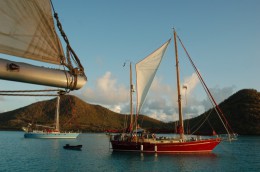
Of course, the next best thing, after meeting up with an old friend, is making a new one – and we did that too, in the Not-Fully-Paid-Up scene outside the paying scene in Jolly Harbour.
The hook had hardly hit the seabed before a couple appeared alongside in their dinghy. “We’ve heard of you!” (A dodgy opener, if I may say so, by the way.) “Will you come and join us for a drink?”
Poor innocents…
“You bet!” The captain of the good ship Mollymawk has never been known to turn down the offer of a drink.
Nine hours and several bottles of rum later we were the everlasting friends of a delightful Scottish couple and their two delightful but somewhat bemused teenaged kids.
It’s good stuff, is rum. If the politicians and the army chiefs only drank more of it, and drank it with their opposite numbers, there’d never be any war.
The Kids Issue Their Verdict
Of course, the renewing of old friendships was our chief purpose in coming to Antigua. That, and the introduction, to Caesar and Xoë, of the land of their birth.
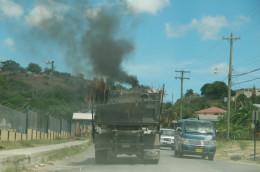
We took a trip across the island and found it to be even more crowded than it used to be, with ugly new villas littering the hillsides which once must have been farmed or forested, and shiny new mega-sized pick-up trucks (or SUVs) choking the roads. The kids were not impressed.
“It’s a bit of a dump,” said Xoë.
“It’s a shame you weren’t working in Dominica,” Caesar added. “I’d like to have been born there.”
“Or even Carriacou.”
“You wait till you see St Maartens,” said I. “Compared to St Maartens this place is paradise.”
“Oh, I hadn’t realised we were going to St Maartens.”
“We aren’t. I can’t stand the place. It’s ghastly.”
The principal delight in Antigua resides not in its rather dreary interior, nor in its people (who are apt to be somewhat rude, even to the point of being racist). The attraction lies in its many splendid anchorages. These lie scattered all around the isle, both on the sheltered leeward side and behind the reef which guards the eastern shore. In this respect Antigua is pretty much unequalled in the Caribbean, and if a yachtsman wanted to visit just a single island – for a charter holiday, perhaps – this would be the one to go for.
English Harbour
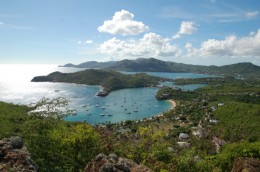
Unfortunately we didn’t have time to circumnavigate the island and visit all of our old haunts, but we pottered round to English Harbour; or rather, to be more exact, we spent seven hours beating against the wind and current in order to cover this distance of about nine miles.

The anchorage off Galleon Beach (in the entrance) was predictably crowded, and someone has evidently decreed that yachts may not moor in the channel leading towards the ancient dockyard and the quay. In the good old days we used to anchor wherever we liked, and the super yachts used to have to work their way carefully through the throng. The bigger ones sometimes had to launch a RIB and send it ahead of them to push the riff-raff gently aside and so clear a temporary path. (Eee by gum; those were the days, eh?)
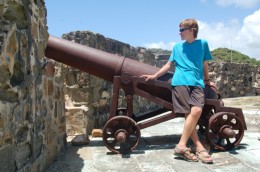
The dockyard was… different; neither better nor worse, but just different. Old shops and bars were gone, but new ones had replaced them. Visitors now pay a fee to gain access to this territory. (And so they should, incidentally, because the preservation of a unique, tropical, 18th century English dockyard costs money.)
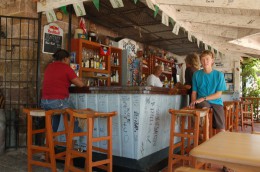
By far the biggest difference lay in the fact that the place was more or less empty of yachts and yachtsmen.
“It’s the height of the season! Where is everybody?”
In our day the quay would have been chock-a-block with charter yachts, from 80 to 200 feet and more in length; the stone paths would have been crowded too, and the bars would have echoed to the laughter of Hooray-Henrys and other members of the super-yacht fraternity.
Just across the water, the old boatyard where Nick once worked also seemed to have dwindled. Two restaurants had appeared on its waterfront. They certainly provide the best dining place in the entire island, and perhaps in the whole Caribbean. Presumably their rent helps to make up for a part of the profits lost to the Jolly Harbour enterprise.
Trouble in Paradise
But where were our old friends?
At Jolly Harbour Nick had come across his old boss, Carl Mitchell:
“Hullo Carl. Remember me? I’m…”
“Nick! ‘Course I remember you! Man, your kids have grown! Has it really been that long?”
Now, in English Harbour, we sought to find Jolyon Byerly. Jol was a mere acquaintance of ours but he was once a close friend of Johnson’s:
“Paul Johnson… Do we know a Paul Johnson, darling?” we heard Jol asking his wife when we telephoned.
Age takes its toll, it seems… and so does the rum bottle. Another friend had died in an alcoholic stupor. (Okay; I s’pose it’s not such good stuff after all.) Another – a good friend with a child the same age as Caesar – was now a heroin addict. Another was in prison.
“Yikes! Is this what it does to you, this lotus-eating lifestyle? Isn’t anybody left?”
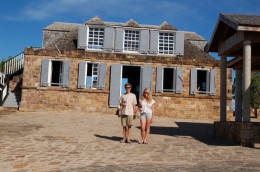
We climbed to the top of Shirley Heights, the famous cliff which overlooks English Harbour. The bar was just closing, but we got in a couple of rounds and sat on the wall gazing at the view. Someone has erected a large sign advising customers not to fall over the edge. Probably a wise precaution for Sunday nights, when the steel band is tapping out its repertoire – plinkety-plinkety-plink – and the place is doing such good business that they’ve had to open a second bar; but probably ineffective. If people are drunk enough to fall off a cliff, they’ll fall anyway, notice or no notice.
We pointed out Falmouth Harbour, narrowly divided from the dockyard by a thin peninsula.
“It’s full of marinas now, as you can see. I guess that’s where the charter yachts have gone.”
“And over there, behind Falmouth, you have… what’s it called….? Can you remember, Nick? Can you remember the name of the hill which overlooks Falmouth? And the fort – can you see the fort up on the top there, Caesar? We used to drive up there. (It’s a wonder the car ever made it, the track is so bad.) That’s the place where the people all used to go and hide when the Frenchies or the Caribs attacked the island.”
“Really? The Caribs attacked the English colonies?”
“Certainly they did! I guess English meat is as tasty as Arawak; more so, perhaps, if it’s the genteel kind, butter-fed and soft after living an easy life.”
“I doubt whether many of the early colonists had an easy life.”
“No. But the cannibals once stole the governor’s wife and her son.”
“Really?”
“Yes. But the governer led a rescue party which followed after the Carib war canoes and attacked Dominica. The boy had already been eaten by the time they got there, but the boss got his wife back. After that he kept her locked in a tower.”
“In a tower!”
“So the story goes. He never let her out of it again until the day she died.”
“It sounds as if he was rather possessive.”
Only one more set of friends remained to be rediscovered – or not, as the case might be.
Denise and Dave had arrived in Antigua by boat at about the same time as us, but unlike us they had swallowed the hook and stayed for good. Their oldest child was the same age as Caesar and I had happy memories of the two of them playing together on the beach and in the dockyard.
We didn’t know what Denise and Dave were up to nowadays, but we had their phone number. Nick tapped it into the machine.
“Fantastic!” Denise cried when she heard who it was. “Oh, wow! I can’t believe it! Amazing! And you’re where? Up at Shirley Heights? Well, you’d better come for tea.”
“But we don’t know where you live.”
“Hang on. I’ll flash you.”
“You’ll what…?”
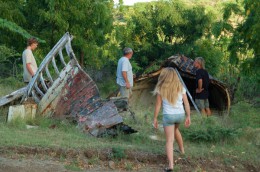
A minute later she was back on the line. “Did you see that?”
“Did we see what?”
“The flash. I’m flashing the bathroom mirror at Shirley Heights.”
“There!” cried Caesar, and sure enough, a bright flash flickered on the hillside below us.
“Denise…! You haven’t changed a bit!”
“Still crazy after all these years, hey?”
“Still crazy.”
And still with her liver and brain intact, and her husband and kids by her side. So – it is possible to survive in paradise.
Drop by in a fortnight for Part IV of this article.
